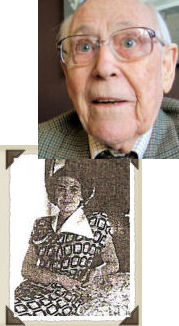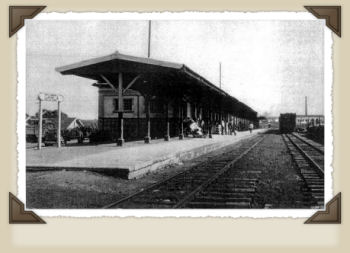Reminiscences
of my 60 years in South America | ||||||||||||||||||||||||
| ||||||||||||||||||||||||
On
a coffee fazenda [coffee plantation] 1952 - 1954 | ||||||||||||||||||||||||
"
It was a glorious life" | ||||||||||||||||||||||||
By train to Garça In April 1952, my wife, baby daughter Barbara and , the Afro Brasilian nursemaid called Cecilia and myself boarded the Paulista train for Garça in the interior of the State of São Paulo. Met by the Assistant Manager we were conveyed by car to the fazenda of Cia Agricola do Rio Tibirica, part of the giant British owned Cambuhy Coffee Estates. We were allotted a bungalow standing in its own grounds in a line with other bungalows for the Manager, Assistant Manager, the Office and the trainee British staff. Our furniture and belongings had already arrived from Rio de Janeiro so the first day was spent putting everything in order. A cook/maid had been engaged for us and she was sent to purchase essential foodstuffs from the fazenda store. There were three of these on the farm selling cloth, kitchen and household utensils and some foodstuffs. We were informed that we were allowed 15 kilos of top grade Coffee per month and 7 litres of milk each day. There were grapefruit, orange, lemon, cherry and plum trees in the back garden as well as pineapples and mamão [paw-paw] . We could keep chickens, ducks, turkeys etc, we could grow our own vegetables, fish could be obtained from the nearby river and we were allowed to purchase the best filet mignon at a ridiculous price. We had reached Heaven! I have always been very partial to milk but even allowing for milk for my family, the nursemaid and the servant, there was milk left over at the end of the day. As we were not allowed to give milk away, at the first opportunity I purchased a cream making machine. Now I made quantities of cream and butter with the excess. I had cream with my breakfast cereals, tea and cream and a glass of cream at night! No wonder I put on weight. The farm cinema My work was not onerous. I had a staff of one. I kept the accounts, wrote occasional letters to Head Office in Sâo Paulo, paid the wages and paid the occasional invoice, Sales of the coffee were controlled and paid for in Sâo Paulo. I was also in charge of choosing the films for our local cinema. Films were shown on Saturday evenings. The British staff sat in a box alongside the projector room. The show could not start until we arrived so if we were having pre-dinner cocktails at say the Manager's house and were a bit late, it was bad luck for the rest of the audience who just had to wait. Truly feudal. Often, if there was a jeep available, I would drive around the estate. The workers would stop and remove their caps as I passed. Apart from coffee, the fazenda also grew beans, rice and corn, all for the use of the people on the fazenda. Silk worms were reared for their silk and we were allowed to purchase lengths of the cloth which was woven on the premises. Apart from horses, we had a herd of milk cows and some bulls which provided not only milk but also meat for the fazenda. Of course we also had complete carpenter and mechanical workshops. There were two types of workers. There were the labourers taken on at the time of the harvest who were known as empreteiros and workers and their families who had yearly contracts to plant, weed and cultivate the crops. These were known as colonos and their contract included a small house and garden in which they might grow vegetables and have a few chickens. It was a hard life though as they had to put in a full day's labour each and every day. If the husband fell sick, his wife had to do the work and in her absence the children. If the work was not done for more than a few days for whatever reason, then the family were thrown off the fazenda. Barbara is bitten by a bicho Meanwhile my daughter was growing up and starting to walk. One day she and the nursemaid were sitting on the lawn in front of the house when the nursemaid gave a shriek. A small snake had passed between her and my daughter. Fortunately neither was bitten as it was a very poisonous snake. On another occasion, a small pimple appeared in the middle of her forehead. At first we ignored it but it grow bigger so we took her to the Hospital in Marillia. One look and the doctor exclaimed "It is a bicho. I have to cut it out at once." He made a slight incision and out came a small insect. The doctor told us that the bicho had laid it's egg in our daughter's forehead and the egg had hatched. I
enjoyed watching the harvest and subsequent categorizing of the coffee into five
grades. The best grade, known as despulpado, naturally commanded the best
price. The fifth grade, which was roasted and ground up in some of the cafes of
São Paulo, consisted not only of the damaged or half ripe beans but also
bits of leaves, twigs and anything else which had been swept up with the rest
of the coffee. Back in Garça, I attempted to put the scheme into operation but I found it more complicated than I had anticipated so I decided to leave it in abeyance until I had an opportunity to visit Head Office in São Paulo and receive more instruction. Decision time It
was a glorious life but we began to worry about our daughter's education. Where
would she go to school? To send her to São Paulo or England would mean
that one of us would have to be with her. And then on the grapevine we heard that
the Brasilian Banking firm, Moreira Salles was considering buying the whole fazenda
when the next coffee crop had been harvested. We decided the time had come to
leave and seek elsewhere. Although I had no other job in mind I decided to resign
as soon as possible and in June 1954 we left for São Paulo. | ||||||||||||||||||||||||
|

